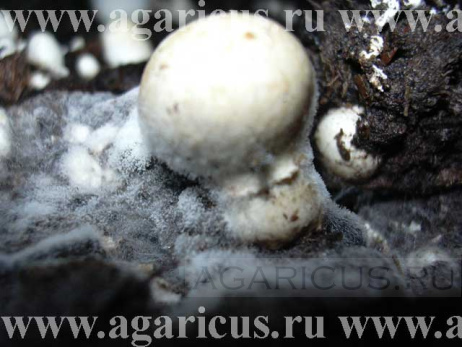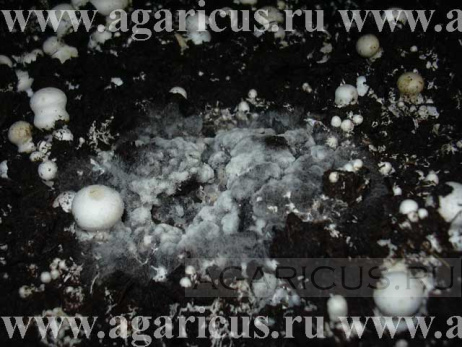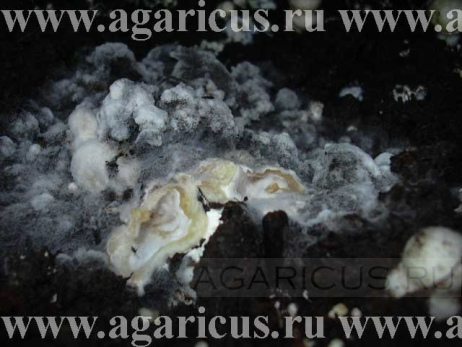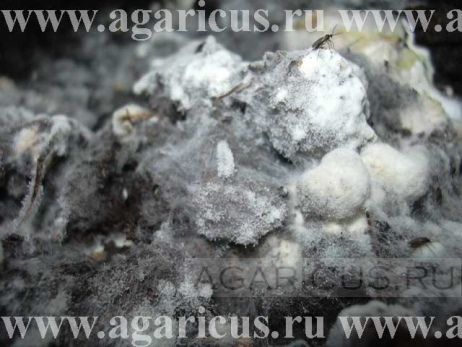Dactylium
Hypomyces rosellus (Cladobotryum dendroides, Daktylium dendroides)
The usually used name «cobweb mold» was obtained by this disease because of the outward appearance of the mycelial growth, which looks like a white cobweb. Appearing on the casing layer as small and white spots, the «cobweb» grows very fast all over the casing surface, colonizing all mushrooms on its way. The diseased mushrooms become covered with white and fluffy mold mycelium, weaken, become brown and rot. The mycelium threads of the mold gradually thicken, becoming a think layer of mold. In time, it becomes reddish-purple in color, and can change to yellow on the later stages of development. During spore-forming, the spore dust is easily spread by wind, or watering the beds. Moreover, Dactylium is easily spread by pieces of mycelium, which stick to personnel’s clothes and implements.
A mushroom damaged by Dactylium mold
A mold spot on the casing layer
The initial infection of the casing mixture with Dactylium can occur at its preparation. Since Hypomyces rosellus lives in soil, it can be easily transferred to the casing mixture with soil. If the disease occurred in one of the growing rooms, then the spores are carried to the other rooms by wind. Moreover, the new infective episodes might be caused by spores and mycelium that have been stuck to the clothes and footwear of employees, who move from room to room, or by waste products that haven’t been taken away from the farm.
Dactylium source that is developing leftover mushroom stipes
Cobweb mold. Flies also spread Dactylium disease.
High relative humidity and high air temperature after the application of a casing mixture stimulate the development of Dactylium. Therefore, close attention must be paid to the cultivation climate.
It is noted that even when the casing layer is strongly infected by cobweb mold spores, its symptoms usually appear during the last waves. But when the casing layer is infected by pieces of Dactylium mold mycelium, the disease symptoms are seen just before the first wave, when pins begin to develop. Very often, the disease begins developing on mushroom stipes that have been left after harvesting, or on dead mushroom fruit bodies.
The mushroom grower must pay close attention to the beds, and at the appearance of first mold spots, take measures to control its further spreading.
In literature, the following control measure can be found:
The usually used name «cobweb mold» was obtained by this disease because of the outward appearance of the mycelial growth, which looks like a white cobweb. Appearing on the casing layer as small and white spots, the «cobweb» grows very fast all over the casing surface, colonizing all mushrooms on its way. The diseased mushrooms become covered with white and fluffy mold mycelium, weaken, become brown and rot. The mycelium threads of the mold gradually thicken, becoming a think layer of mold. In time, it becomes reddish-purple in color, and can change to yellow on the later stages of development. During spore-forming, the spore dust is easily spread by wind, or watering the beds. Moreover, Dactylium is easily spread by pieces of mycelium, which stick to personnel’s clothes and implements.
A mushroom damaged by Dactylium mold
A mold spot on the casing layer
The initial infection of the casing mixture with Dactylium can occur at its preparation. Since Hypomyces rosellus lives in soil, it can be easily transferred to the casing mixture with soil. If the disease occurred in one of the growing rooms, then the spores are carried to the other rooms by wind. Moreover, the new infective episodes might be caused by spores and mycelium that have been stuck to the clothes and footwear of employees, who move from room to room, or by waste products that haven’t been taken away from the farm.
Dactylium source that is developing leftover mushroom stipes
Cobweb mold. Flies also spread Dactylium disease.
High relative humidity and high air temperature after the application of a casing mixture stimulate the development of Dactylium. Therefore, close attention must be paid to the cultivation climate.
It is noted that even when the casing layer is strongly infected by cobweb mold spores, its symptoms usually appear during the last waves. But when the casing layer is infected by pieces of Dactylium mold mycelium, the disease symptoms are seen just before the first wave, when pins begin to develop. Very often, the disease begins developing on mushroom stipes that have been left after harvesting, or on dead mushroom fruit bodies.
The mushroom grower must pay close attention to the beds, and at the appearance of first mold spots, take measures to control its further spreading.
In literature, the following control measure can be found:
- strew the mold spot with salt of backing soda, or treat the damaged areas with 2% of industrial (40%) formalin solution, and immediately strew it with ground lime. Lime contains formalin vapors, so that way, the nearby healthy mushrooms won’t be damaged. When the beds are cleaned, white spots of salt and lime are clearly visible and they can be removed, when a bigger casing layer area is included. Moreover, the relative humidity and air temperature have to be decreased; the air circulation can be increased.
- The casing layer has to be prepared in a clean, disinfected room. If necessary, the casing layer can be watered with 2% of formalin solution or fungicide solution, right after it’s been applied.
- The relative humidity and air temperature have to be maintained.
- The transfer of infection to the healthy mushrooms has to be avoided, by organized movement of pickers.
- Abide by the rules of sanitation and hygiene on the whole farm.





Lko:
Saheb hamare mushroom dry bable se pura form doob chuka hai ismein Ham Kya Karen Sahab Koi upay Ho to...
Production of Compost, Personal opinion (part 3). Wet...Abimbola Olaniyi-Balogun, Lagos Nigeria:
Hello there, I made mushroom compost using the long composting method. I used wet chicken manure, fresh...
Mushrooms in KazahstanZagreb, Croatia:
My name is Zlatko Vidmar.
Without chicken manure compost? Yes, it's possible...I am in modern mushroom growing over 40 years.
I see your farm and if...
nanyuki:
my email is samuelnjogo@gmail.com
Without chicken manure compost? Yes, it's possible...nanyuki:
i want to learn like a child on compost making for mushroom
Mushrooms in KazahstanVELLORE TAMILNADU INDIA:
SUITABLE JOBS – MUSHROOMS GROWER / COMPOST / SPAWN OR RELAVANT FIELDS
Without chicken manure compost? Yes, it's possible...Dear Hiring Manager...
Patna:
PLEASE SEND YOUR FORMULA without-chicken-manure-compost
watering first flush mushroomswasil, Malaysia:
i suggest you not to water on mush just maintain the good humidity if you not have any auto system for...
Compost Production. Personal opinion (Part 2)NARENDER SEHRAWAT, FARIDABAD NCR:
COMMON PROBLEM IN PHASE 1 BUNKAR IS THE UNBALANCED TEMERATURE, IT STARTS FROM 50-55 DEGREES TO 78-82...
Without chicken manure compost? Yes, it's possible...Hannes, Plettenberg Bay, South Africa:
Can you give me more details on compost without chicken manure for mushroom growing, what alternatives...